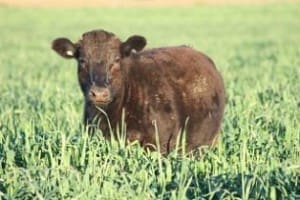 For the second time in two years, demand for oats planting seed from northern New South Wales to Central Queensland is set to outstrip supplies of key varieties.
For the second time in two years, demand for oats planting seed from northern New South Wales to Central Queensland is set to outstrip supplies of key varieties.
Oats seed suppliers are reporting strong forward demand for planting seed, even after recent rainfall eased some of the seasonal pressure facing producers in oats growing areas.
The recent rain has come too late to provide a full summer of grass growth, making a winter oats crop an attractive option for producers with available soil moisture to generate a body of feed to carry cattle through to spring.
As with last year, producers are again being urged act quickly to secure seed, with supplies of key varieties already looking tight according to suppliers and Government staff contacted by Beef Central this week.
In 2014, a burst of widespread rainfall in late March which followed an extended dry period triggered a sudden rush of demand for forage oats seed which quickly exhausted available stocks.
As a result many producers in Queensland were only able to access varieties developed for southern areas which were more susceptible to leaf rust and less capable of providing an extended grazing opportunity in northern conditions.
Last week the Queensland Department of Agriculture, Fisheries and Forestry released its annual forage oats guide, a handy reference source designed to help growers plan ahead for this year’s plantings.
The new brochure provides guidelines on improving crops, including an updated list of commercially available forage oat varieties from seed merchants, and extensive agronomic and disease information that growers can use to increase productivity of forage oat crops. The new guide can be downloaded from the QDAFF website by clicking here.
QDAFF senior plant breeder Bruce Winter told Beef Central that tonnages harvested from commercial oats seed growing blocks appeared likely to be lower again this year because of drought conditions.
On the demand side there had already been reports of strong forward sales of available seeds as growers acted in advance of an expected dry summer and bought seed early.
“With the rain since mid-December the pressure has come off a little so there won’t be quite as much demand and that would have eased the situation a bit,” Mr Winter said.
“However the rain has come quite late in the season and there won’t be as much standing feed as a lot of livestock producers would be used to at the end of summer, so I would expect there should be reasonably good plantings this year again.
“The message for growers is that if you are thinking about planting oats this year, try to secure your seed as early as you can.”
Ben Adams from Pacific Seeds in Toowoomba said the seed supply outlook for 2015 was looking to very similar to what happened in 2014.
“Demand has been especially strong given the lack of feed and the relatively high cattle prices driving growers to look for oats planting seed,” Mr Adams said.
“At this stage seed supply is below the above average demand and seed is difficult for growers to find, especially if they have not yet placed an order with a retailer.
“I would expect older varieties will be planted and will need to be managed to control rust.”
QDAFF senior plant breeder Bruce Winter said seed brought north into Queensland from southern states to satisfy demand last year included rust-susceptible types and grain varieties which were fast growing early but not designed to tiller out later in the season and therefore did not recover well from grazing.
“The message would be to generally avoid those if possible,” Mr Winter said.
“But sometimes growers need to plant something to get some feed in the ground, so if you need to plant those varieties the advice would be to get a germination test so you know that the seed is going to germinate.
“Also think about the purity of the seed and how many weed seeds might be in there.”
Leaf rust can build very quickly on susceptible varieties, dramatically reducing forage yield and impacting on feed quality and palatability.
Rust spores, which spread through the air, survive over summer on oat stubble, volunteer oat plants and wild oats and can readily infect new oat crops, particularly if planted too early in the season.
“To reduce the risk of leaf rust infection and poor establishment, growers should choose resistant varieties if possible and only plant forage oats from mid-March through to June,” Mr Winter said.
“Good nutrition is also important and the fertiliser requirement for a high yielding forage oat crop is similar to wheat.”
The new Forage Oats guide has been produced by QDAFF with funding from Meat and Livestock Australia.
Should barley be part of the winter forage mix?
In years gone by farmers in oats growing areas have included barley in their winter forage program to mitigate against the risk of their oats crop succumbing to rust.
Barley is faster growing and can produce feed on a planting rain.
Mr Winter told Beef Central that barley can be a very good alternative to forage oats particularly on a later planting.
“Barley has much quicker emergence than oats during the cooler months of May and June, and will provide quicker feed than oats at that time.
“However, barley doesn’t recover from grazing as well as oats later in the season.
“Growers also should be careful of awns on the barley heads late in the season, although several awnless forage barley varieties are available.
“The best approach is to plant a range of different varieties of both oats and barley to provide feed at different times of the season and manage accordingly.”



HAVE YOUR SAY